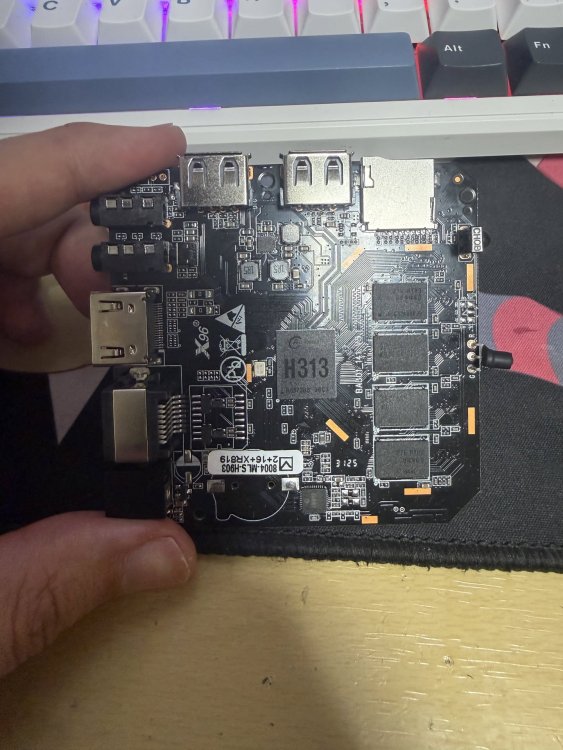Active threads
Showing topics posted in for the last 365 days.
- Past hour
-

Very simple module for nothing, Segmentation fault
Henrik Larsson replied to Kopia's topic in Allwinner sunxi
I am having the same issue on Nanopi Neo Air and uname -r 6.12.51-current-sunxi I can't find a solution. I can also as @mue473 mentioned see that prebuild kernel modules: readelf -r netlink_diag.ko | grep cleanup 00000000 00003402 R_ARM_ABS32 00000001 cleanup_module 000002d4 00003402 R_ARM_ABS32 00000001 cleanup_module while my own has readelf -r testm.ko | grep cleanup 00000000 00004902 R_ARM_ABS32 00000001 cleanup_module 000002c4 00004902 R_ARM_ABS32 00000001 cleanup_module I have no idea though if this matters at all. Does anyone know? -
Installing 'wireguard' caused lots of problems, but wireguard-tools works after restart.
- Today
-

Armbian with preinstalled OpenMediaVault (OMV)
d1nuc0m replied to Igor's topic in Software, Applications, Userspace
Hi all, I just installed Armbian Linux v6.12 with OpenMediaVault (build date 2025/09/23) on a Odroid HC4. When I try to use apt update I get these errors Get:1 file:/var/cache/openmediavault/archives InRelease Ign:1 file:/var/cache/openmediavault/archives InRelease Get:2 file:/var/cache/openmediavault/archives Release Ign:2 file:/var/cache/openmediavault/archives Release Get:3 file:/var/cache/openmediavault/archives Packages Err:3 file:/var/cache/openmediavault/archives Packages Method gave a blank filename Get:3 file:/var/cache/openmediavault/archives Packages Err:3 file:/var/cache/openmediavault/archives Packages Method gave a blank filename Get:3 file:/var/cache/openmediavault/archives Packages Err:3 file:/var/cache/openmediavault/archives Packages Method gave a blank filename Get:3 file:/var/cache/openmediavault/archives Packages Err:3 file:/var/cache/openmediavault/archives Packages Method gave a blank filename Get:3 file:/var/cache/openmediavault/archives Packages Err:3 file:/var/cache/openmediavault/archives Packages Method gave a blank filename Get:3 file:/var/cache/openmediavault/archives Packages Err:3 file:/var/cache/openmediavault/archives Packages Method gave a blank filename Get:3 file:/var/cache/openmediavault/archives Packages Is this expected and related to Armbian setup or should I ask on OMV forum? -

mxq pro 4k 5g allwinner h313 can't sd card boot
Sergey Lepeshkin replied to Ducdanh Nguyen's topic in Allwinner CPU Boxes
@Ducdanh Nguyen, I don't understand how you could use electrical (insulation?) tape to connect to test points... Nevertheless, all you need is a good electrical contact between wires and test points. Means has no matter. Beware: signal levels is 3.3V. Do not connect directly to RS232 interface! What about flashing my modified update.zip - don't worry. It doesn't alter partition table, bootloader and backup partition. If something goes wrong, or you just want original firmware back - just connect power while holding button near "A/V" jack. This will start reflashing using your original update.zip, located in backup partition. If you want to extract your original update.zip from backup partition, simplest way to do this is using uart. Connect uart to pc, boot tv box normally, open serial port on pc (115200/8/n/1), issue 'su' command, mount /backup and copy /backup/update.zip anywhere you want. About laptop - I don't understand, how it's related to this discussion... If you want to compile armbian using it - go ahead. It doesn't matter what cpu architecture or type of memory it uses. All you need is correct toolchain, which suits our tv box SoC. -
merged. forum tag added.
-
I think I messed something up in the system, maybe with the repositories, but I get this message when updating... apt update Stary:1 http://deb.debian.org/debian bookworm InRelease Stary:2 http://security.debian.org bookworm-security InRelease Stary:3 https://download.docker.com/linux/debian bookworm InRelease Stary:4 http://deb.debian.org/debian bookworm-updates InRelease Stary:5 http://deb.debian.org/debian bookworm-backports InRelease Stary:6 https://dtcooper.github.io/raspotify raspotify InRelease Stary:7 https://github.armbian.com/configng stable InRelease Stary:8 http://armbian.lv.auroradev.org/beta bookworm InRelease Czytanie list pakietów... Gotowe Budowanie drzewa zależności... Gotowe Odczyt informacji o stanie... Gotowe 1 package can be upgraded. Run 'apt list --upgradable' to see it. root@orangepi3-lts:~# apt list --upgradable Listing... Gotowe armbian-bsp-cli-orangepi3-lts-current/bookworm 25.11.0-trunk.401 arm64 [upgradable from: 25.8.0-trunk.49] N: There is 1 additional version. Please use the '-a' switch to see it root@orangepi3-lts:~# apt list --upgradable -a Listing... Gotowe armbian-bsp-cli-orangepi3-lts-current/bookworm 25.11.0-trunk.401 arm64 [upgradable from: 25.8.0-trunk.49] armbian-bsp-cli-orangepi3-lts-current/now 25.8.0-trunk.49 arm64 [installed,upgradable to: 25.11.0-trunk.401] maybe someone has already dealt with this message and error?
-

CSC Armbian for RK3318/RK3328 TV box boards
sr4armbian replied to jock's topic in Rockchip CPU Boxes
Armbian Version: 6.12.56-current-rockchip64 TV Box: I have same board that is mentioned at this post. Issue: using the .dts mentioned in the above link I am able to see the clock with blinking separator. However I am not seeing the disk activity or LAN connections icon. If I am using devicetree changed to rk1188-box-led-conf-5, I can see the disk blinking icon and LAN connection, however the clock is not visible. Is there anyway I can get the clock as well the icons? Can you share the steps or the post that has the solution to this? -

Rupa X88 Pro 13 - RK3528 board with images
CyberHaZard replied to fedes_gl's topic in Rockchip CPU Boxes
When I first flashed your latest image, the USB2 port did not work, only the blue port works. I then applied this overlay and after rebooting it now works. USB3 speed is still not functional. rk3528-x88pro13-usb2ndhost.dts rk3528-x88pro13-usb2ndhost.dtbo -
I got interested after reading this thread and ordered an X96Q from AliExpress. The board is marked as V5.1, so I thought it would be straightforward, but after two days of trying, no matter which image I use, it always boots into Android. I tried UART communication, but nothing appeared. I even applied the secure boot patch and built it, just in case, but it still wouldn’t boot. How can I get this machine to boot from an SD card? I’m attaching photos of my board and the extracted DTS for reference. dtb.0.dts
-
I found a TX box X96 Mini with rk3228 chip and I try to boot with multitool but it is stuck with a red ligh. I try multitool and multitool2, with no success, can someone tell me what I am doing wrong ? Thank you The multitool i used are from here i used balena etcher to burn the image I also try to short pins on eMMc (around 45 times...) but nothing works from me. Now i order a male-male cable on amazon. edit: added front/left photos
-
It sounds very promising for Espressobin usage and further kernels upgrades. It is yet to discover how could your u-boot port be built and which changes to code should be made for espressobin v5 and v7. I believe, they use the same chip. As you have a working build environment already, it would be worth sharing your pre-built binaries for testing in the 1st run. It could be a big step forward. Probably Armbian could offer them for downloads as well as alternatives in parallel with their own builds.
-
Different soc and even different soc family. This most likely will not work on h618.
-
This is a reply to treii28's post from 2023: To enable i2c on PH4 and PH5 pins, one would have to have to following lines in /boot/armbianEnv.txt files: Reboot and see the new devices with: Scan for all the connected i2c devices: All relevant (and some extra) overlays can be seen with the following command: To see the configuration one could disassemble the dtb binary file and search it's contents for i2c3-ph Whenever making changes it would be the best to connect a serial monitor to the physical serial pins (3 separate pins labeled with UART and GND, RX, TX) to see kernel output at boot (115200 baud rate). The kernel log would have a line for loading the dtbo (or maybe an error for missing file: For easier reference there are included lsmod output, kernel config and dts files from an armbian and the opiz version for "original" debian image (distributed by a sketchy Google drive link, it runs an unnecessary service with weird software repositories enabled by default). lsmod-armbian lsmod-opiz kernel-armbian.config kernel-opiz.config opz3-armbian.dts opiz3-opiz.dts
-

Gaming experience with Orange Pi 5 (RK3588) on Armbian
nom replied to KhanhDTP's topic in Orange Pi 5
This is truly incredible. I had no idea Mali and Linux has come this far. Though it's a shame things aren't mainlined. -

Orange Pi Zero 3 ili9486 TFT LCD (WaveShare 35a)
robertoj replied to goodfvh _YT_'s topic in Allwinner sunxi
Start with this DTS and change the GPIO for your OPIZ3 https://github.com/raspberrypi/linux/blob/rpi-6.12.y/arch/arm/boot/dts/overlays/piscreen-overlay.dts Or start with your DTS and change the "compatible" line to "compatible=waveshare,rpi-lcd-35" and copy the other parameters of piscreen-overlay.dts if needed Let us know if it works -
TV Box Status Information Template Version 1.0 TV Box Name (example: TX3 mini): T9 CPU (example: amlogic s905w): RK3328 Armbian build file name: Armbian_community_25.11.0-trunk.367_Rk3318-box_trixie_current_6.12.54_minimal.img DTB file used: rockchip/rk3318-box.dtb Kernel Version: 6.12.56-current-rockchip64 Distribution Installed (focal, buster, etc): trixie Working Ethernet (Yes/No):Yes Max Ethernet Speed that works (100/1000): 100 Max Does wifi work (Yes/No): Yes 2/5 Does bluetooth work (Yes/No): Yes Does HDMI audio work (Yes/No): Yes - after last update , (also analog and spdif ports are available - not tested). Additional Comments (provide any additional information you feel is important): IR Receiver yes 5 Digit display working: yes MASKROM PINS for recovery flashing available on the back side. SOC RK3328 RAM 4Gx4 D9PQL VFD DRIVER FD6551 WLAN CHIP SP6330 32 GB EMMc KLMBG2JENB VT RT9045 vfd.conf rk3318-t9.dtso Log android gpio T9.txt
- Yesterday
-

Help wanted to test a new OpenVFD alternative
GmP replied to Jean-Francois Lessard's topic in Amlogic meson
Update I have opened the box. Indeed the driver is an FD6551 and the SOC is RK3328. I was using the FD655 just because that was the one used in a working vfd-openvfd conf file. So I have just changed the dtso file directive compatible = "fdhisi,fd6551"; The advantage is that 8 levels of intensity are now available using 1..8 in "echo 1 > /sys/class/leds/display/brightness". I did not chage the filename but as a matter of fact it should be as well the working rk3328-t9.dtso. rk3318-t9.dtso -
Any Ubuntu Noble release?
-
the two tv box are quite different.The rk3318-H50 of this post is quite cheap, so are the component inside. By the way for the rk3318-H50: the PMIC is a DF1517, not an usual one. The Board has three leds (one red is power on always on the other two are both blu but I have never seen them on) and a 4 digit display plus (colon) usb, lan and wlan icons. Wifi works with the base configuration 2 and 5 ghz (although some warnings in the log). Bluetooth is recognized as well. I do not see any message related to the IR receiver. By the way it seems to be quite stable. This is the gpio list: android_tv_box_32:/ $ cat /sys/kernel/debug/gpio gpiochip0: GPIOs 0-31, parent: platform/pinctrl, gpio0: gpio-2 ( |vcc_otg_vbus ) out hi gpio-30 ( |vcc_sd ) out hi gpiochip1: GPIOs 32-63, parent: platform/pinctrl, gpio1: gpio-42 ( |bt_default_rts ) out lo gpio-50 ( |reset ) out hi gpio-53 ( |bt_default_poweron ) out hi gpio-56 ( |fd650_scl ) out hi gpio-57 ( |fd650_sda ) out hi gpio-58 ( |bt_default_wake_host) in hi gpiochip2: GPIOs 64-95, parent: platform/pinctrl, gpio2: gpio-81 ( |vcc_host_vbus ) out hi gpio-82 ( |power-led-ir ) out lo gpio-90 ( |power-led-normal ) out lo gpiochip3: GPIOs 96-127, parent: platform/pinctrl, gpio3: The T9 is an old and quite different TVBOX (cames in two flavours rk3318 and rk3328 from Sunwell) and everything is working "out of the box" - wifi, bluetooh, lan, hdmi, ir receiver. It has no leds but a 5 digit display + 6 icons but if you think it would be useful I can open it and peraphs describe it in a different post to avoid confusion. It seems to me that is more widespread as there are configuration files all around. Let me know if it is of ant interest.
-
Hi all, I just installed Armbian with OpenMediaVault on a Odroid HC4 (v25.8.2 for Odroid HC4 running Armbian Linux 6.12.48-current-meson64), when I tried to disable automatic updates in armbian-config it purged a lot of packages including openmediavault. Guess this is a bug, in case where should I report it?
-

Installation Instructions for TV Boxes with Amlogic CPUs
Solder Anget replied to SteeMan's topic in FAQ
IS THERE ANYTHING COMPATIBLE FOR S905Y4 VERSION -

Armbian Linux v6.1 - Bluetooth not working - no BT controller found
SM2027 replied to SM2027's topic in Banana Pi M7
A service was created to fix the issue, should be this added to official BPI-M7 image? sudo nano /etc/systemd/system/btattach.service sudo systemctl daemon-reload sudo systemctl enable btattach.service sudo systemctl status btattach.service sudo systemctl start btattach.service sudo systemctl status btattach.service cat /etc/systemd/system/btattach.service [Unit] Description=Bluetooth UART Attach Service After=network.target Before=bluetooth.service [Service] Type=simple ExecStartPre=/usr/sbin/modprobe bluetooth ExecStartPre=/usr/sbin/modprobe hci_uart ExecStart=/usr/bin/btattach -B /dev/ttyS6 -P bcm -S 115200 Restart=always [Install] WantedBy=multi-user.target -
Hi, can you confirm that the OLED is working connecting it to another device (raspberry, Arduino)? It should be properly powered, cables should be checked if ok. Also, check in the spec if pull-up resistors are needed. You can force a scan of all i2c addresses again like this: # Force scan all addresses for i in {0..127}; do sudo i2cget -y 1 $i 2>/dev/null && echo "Device found at: 0x$(printf '%02x' $i)" done
- Last week
-
Getting video acceleration is realtively easy in bookworm, but making it work in Trixie would be newsworthy
-
Thanks for the reply! I bought used and had no luck at all getting things running (this was some time ago and things are hazy). Have you written up your experience anywhere I could look at? Sent from my iPhone using Tapatalk











